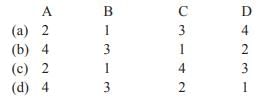UPSC Exam > UPSC Questions > Match List-I with List-II and select the corr...
Start Learning for Free
Match List-I with List-II and select the correct answer given below:


- a)A
- b)B
- c)C
- d)D
Correct answer is option 'A'. Can you explain this answer?
Verified Answer
Match List-I with List-II and select the correct answer given below:a)...
The electron was discovered in 1896, by the British physicist J. J. Thomson, using cathode rays while doing discharge tube experiments. In 1886, Eugen Goldstein discovered the existence of a new type of rays in discharge tube and named as anode rays or canal rays. Canal or anode rays travel in straight line and are deflected by electric field towards cathode which proves that they are composed of positively charged particles. These lightest positively charged particles were named and characterised as protons by Ernest Rutherford in 1919 who purposed Rutherford model for atom to explain the atomic structure. Anti-electron or in other words the positron was discovered in 1932 by Anderson, a physicists and he found that the bombardment of boron with an alpha particle resulted in the emission of this particle. In 1932, James Chadwick, an English physicist who had worked with Rutherford, detected neutrons.

|
Explore Courses for UPSC exam
|

|
Similar UPSC Doubts
Match List-I with List-II and select the correct answer given below:a)Ab)Bc)Cd)DCorrect answer is option 'A'. Can you explain this answer?
Question Description
Match List-I with List-II and select the correct answer given below:a)Ab)Bc)Cd)DCorrect answer is option 'A'. Can you explain this answer? for UPSC 2025 is part of UPSC preparation. The Question and answers have been prepared according to the UPSC exam syllabus. Information about Match List-I with List-II and select the correct answer given below:a)Ab)Bc)Cd)DCorrect answer is option 'A'. Can you explain this answer? covers all topics & solutions for UPSC 2025 Exam. Find important definitions, questions, meanings, examples, exercises and tests below for Match List-I with List-II and select the correct answer given below:a)Ab)Bc)Cd)DCorrect answer is option 'A'. Can you explain this answer?.
Match List-I with List-II and select the correct answer given below:a)Ab)Bc)Cd)DCorrect answer is option 'A'. Can you explain this answer? for UPSC 2025 is part of UPSC preparation. The Question and answers have been prepared according to the UPSC exam syllabus. Information about Match List-I with List-II and select the correct answer given below:a)Ab)Bc)Cd)DCorrect answer is option 'A'. Can you explain this answer? covers all topics & solutions for UPSC 2025 Exam. Find important definitions, questions, meanings, examples, exercises and tests below for Match List-I with List-II and select the correct answer given below:a)Ab)Bc)Cd)DCorrect answer is option 'A'. Can you explain this answer?.
Solutions for Match List-I with List-II and select the correct answer given below:a)Ab)Bc)Cd)DCorrect answer is option 'A'. Can you explain this answer? in English & in Hindi are available as part of our courses for UPSC.
Download more important topics, notes, lectures and mock test series for UPSC Exam by signing up for free.
Here you can find the meaning of Match List-I with List-II and select the correct answer given below:a)Ab)Bc)Cd)DCorrect answer is option 'A'. Can you explain this answer? defined & explained in the simplest way possible. Besides giving the explanation of
Match List-I with List-II and select the correct answer given below:a)Ab)Bc)Cd)DCorrect answer is option 'A'. Can you explain this answer?, a detailed solution for Match List-I with List-II and select the correct answer given below:a)Ab)Bc)Cd)DCorrect answer is option 'A'. Can you explain this answer? has been provided alongside types of Match List-I with List-II and select the correct answer given below:a)Ab)Bc)Cd)DCorrect answer is option 'A'. Can you explain this answer? theory, EduRev gives you an
ample number of questions to practice Match List-I with List-II and select the correct answer given below:a)Ab)Bc)Cd)DCorrect answer is option 'A'. Can you explain this answer? tests, examples and also practice UPSC tests.

|
Explore Courses for UPSC exam
|

|
Signup for Free!
Signup to see your scores go up within 7 days! Learn & Practice with 1000+ FREE Notes, Videos & Tests.


























